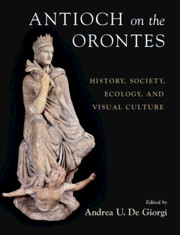Book contents
- Antioch on the Orontes
- Antioch on the Orontes
- Copyright page
- Dedication
- Contents
- Plates
- Figures
- Tables
- Contributors
- Abbreviations
- Antioch on the Orontes
- Part I Beginnings
- Part II The Making of a Capital
- Part III The People of Antioch
- Part IV Religion
- Chapter 22 The First Christians of Antioch
- Chapter 23 Christian Antioch
- Chapter 24 Julian in Antioch
- Chapter 25 The Churches of Antioch in the Life of the City
- Chapter 26 Who Is Jesus Christ?
- Part V Crises and Resilience
- Index
- Plate Section
- References
Chapter 26 - Who Is Jesus Christ?
Theological Controversies in Antioch (Fourth to Sixth Centuries CE)
from Part IV - Religion
Published online by Cambridge University Press: aN Invalid Date NaN
- Antioch on the Orontes
- Antioch on the Orontes
- Copyright page
- Dedication
- Contents
- Plates
- Figures
- Tables
- Contributors
- Abbreviations
- Antioch on the Orontes
- Part I Beginnings
- Part II The Making of a Capital
- Part III The People of Antioch
- Part IV Religion
- Chapter 22 The First Christians of Antioch
- Chapter 23 Christian Antioch
- Chapter 24 Julian in Antioch
- Chapter 25 The Churches of Antioch in the Life of the City
- Chapter 26 Who Is Jesus Christ?
- Part V Crises and Resilience
- Index
- Plate Section
- References
Summary
The fourth century AD historian Ammianus Marcellinus remarked that “no wild beasts are such enemies to mankind as are most of the Christians in their deadly hatred of one another.” More to the point, the discussion of the nature of Christ drove a wedge within Christian communities in Antioch as elsewhere and ignited conflicts on a unprecedented scale. This chapter describes how the playing out of these debates had repercussions at all the levels of Antiochene society.
- Type
- Chapter
- Information
- Antioch on the OrontesHistory, Society, Ecology, and Visual Culture, pp. 420 - 430Publisher: Cambridge University PressPrint publication year: 2024



